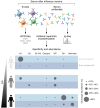Decreased vaccine protection of egg-based influenza vaccine in the elderly and nonhemagglutinin-focused immunity
- PMID: 34338229
- PMCID: PMC8321562
- DOI: 10.1172/JCI151732
Decreased vaccine protection of egg-based influenza vaccine in the elderly and nonhemagglutinin-focused immunity
Abstract
Severe influenza illness or death is a serious concern among the elderly population despite vaccination. To investigate how the adaptive immune response after vaccination varies with the patient's age, Jung et al., in a recent issue of the JCI, extensively analyzed the serum antibody response in different age groups after immunization with the egg-based influenza vaccine Fluzone. As expected, the immune response in young adults was dominated by antibodies targeting the influenza hemagglutinin (HA) protein. On the contrary, the serological repertoire of elderly donors was characterized by cross-reactive (CR) antibodies recognizing non-HA antigens. Surprisingly, a substantial fraction of these CR antibodies targeted sulfated glycans typical of egg-produced proteins, which does not provide protection against human influenza viruses. Overall, these findings are of great value in understanding suboptimal immunity after influenza vaccination and shaping future vaccine efforts that will achieve increased protection in the elderly.
Conflict of interest statement
Figures

Comment on
-
Influenza vaccination in the elderly boosts antibodies against conserved viral proteins and egg-produced glycans.J Clin Invest. 2021 Jul 1;131(13):e148763. doi: 10.1172/JCI148763. J Clin Invest. 2021. PMID: 34196304 Free PMC article.
References
-
- Centers for Disease Control and Prevention. 2018-2019 Flu Season Burden Estimates. https://www.cdc.gov/flu/about/burden/2018-2019.html Accessed July 7, 2021.
-
- Hannoun C, et al. Immunogenicity and protective efficacy of influenza vaccination. Virus Res. 2004;103(1–2):133–138. - PubMed
Publication types
MeSH terms
Substances
Grants and funding
LinkOut - more resources
Full Text Sources
Medical
Research Materials

